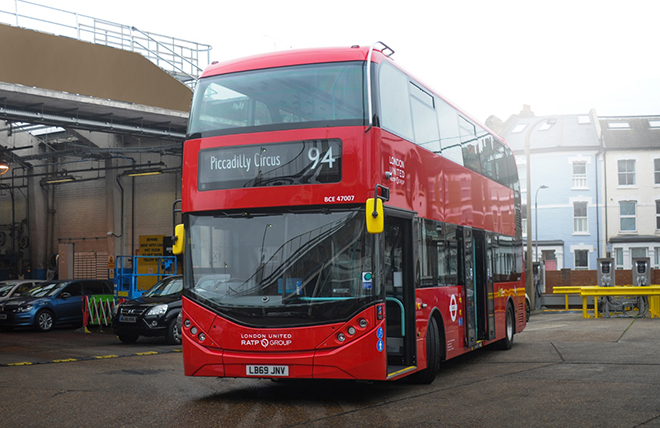
V2G is one of the hottest topics in the EV world. Using EVs as a giant virtual battery is a promising prospect for electric utilities—it would offer them an efficient, cost-effective way to manage demand and facilitate the integration of more renewable energy sources into the grid (and create a powerful incentive for them to encourage EV adoption).
Nissan, Honda and others are testing V2G systems. However, electric buses arguably present more potential for large-scale V2G applications than passenger cars, because of their larger battery capacity and their predictable duty cycles.
London already has the largest electric bus fleet of any city in Europe. Now it’s the site of what’s being billed as the world’s largest V2G pilot.
The Bus2Grid project is a joint effort that involves SSE Enterprise, Leeds University, UK Power Networks, Transport for London and BYD, as well as Go Ahead London, which currently operates 240 e-buses in Britain.
The initial trial will aggregate the batteries of 28 BYD double-decker buses into a system that’s capable of returning over 1 MW of power to the grid. And bigger things could be in store. The Northumberland Park bus garage has been transformed to house nearly 100 e-buses. SSE Enterprise, which is overseeing the deployment of bi-directional charging for the project, says that if London’s entire fleet of 9,000 vehicles were to be V2G-enabled, it could power 150,000 homes.

“Central to the challenge of decarbonising our transport is how we can optimise the existing flexibility within the energy system,” said Niall Riddell, Smart Systems Innovation Sector Director for SSE Enterprise. “Developing a charging infrastructure that operates in two directions so that batteries can give back as well as take from the grid is an important part of this. SSE Enterprise is proud to have electrified most of the bus garages in London that operate electric buses. Delivering the Bus2Grid project is the next natural step in using smart technology to make bidirectional charging the reality for today’s bus users.”
“Large electric vehicles like these can also support the energy system, but this means creating new ways of working between energy utilities, grid managers, and transport providers,” said Dr. Stephen Hall of the University of Leeds. “This project is creating new business models to make this happen.”
UK Power Networks expects to have 3.6 million EVs connected to its network by 2030, creating significant additional energy demand. V2G offers a way to avoid building expensive new infrastructure. “A fleet of bus batteries harnesses large amounts of electricity, and they [have] regular and predictable routes, driving patterns and timings,” said Ian Cameron, Head of Innovation at UK Power Networks. “That means we can easily predict and plan for how we can use any spare electrical capacity they can offer.”
Source: SSE Enterprise, Green Car Reports
source https://chargedevs.com/newswire/london-v2g-pilot-includes-28-electric-double-decker-buses/
No comments:
Post a Comment